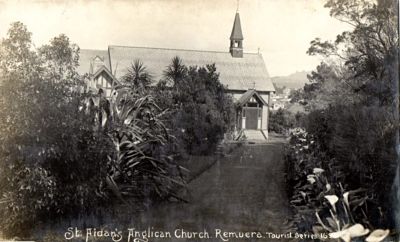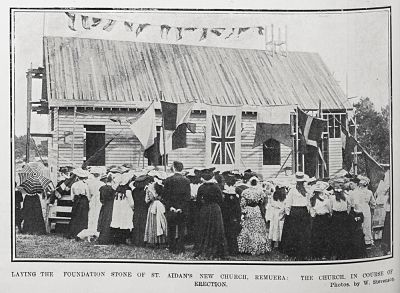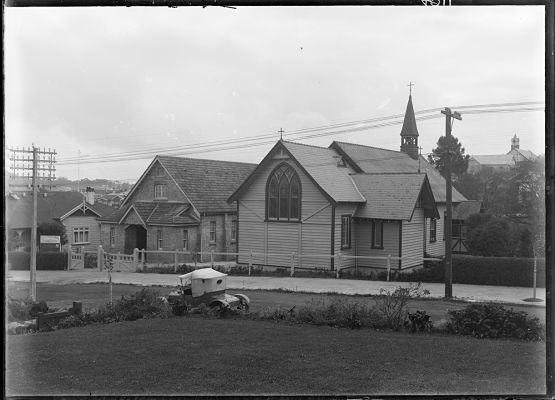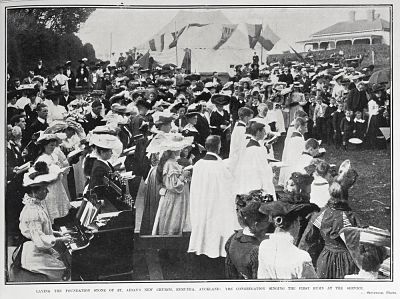The Planning and Building of St Aidan’s Church
Originally, St Mark’s parish stretched from the smelly abattoir village of Newmarket in the west to the native reserve past St John’s College in the east, and from the Great South Road across to the eastern bays; so it was a very, very long walk to church for Anglicans living in the further reaches of that area if they didn’t have a horse and carriage.
The Rev I D Richards, an early vicar at St Mark’s, had realised this and persuaded the diocesan office to buy a section of land halfway down Victoria Avenue in the 1860’s.
In the meantime, the far-out parishioners used St Mark’s mainly for baptisms, weddings and funerals, attending the usual weekly services at two informal centres – Mandeno’s church, at the top of Orakei Road, and Wilson’s Barn, at the bottom of Victoria Avenue. They had been built and made available to all denominations by liberal, community minded men: the Rev James Mandeno, a Congregationalist-settler-farmer and J Liston Wilson, one of the sons of the founder of the New Zealand Herald. Their services were taken by the current St Mark’s curate, or by lay readers. Anglicans who attended at these places said they belonged to either the Upper or Lower Remuera Church Hall Services.
However, when Mandeno retired in 1874, his church buildings were sold to the Presbyterians and transported along Remuera Road, thus founding St Luke’s church. The worshippers in the Upper Remuera Church were left churchless and had to make do with a smaller hall, built later by the Proberts on the section left vacant.
In 1898, with the concurrence of the St Mark’s vestry, the Upper Remuera parishioners decided it was time for a church of their own and formed a committee for this purpose. The members were well-off Remuera land owners: Thomas Finlayson, the chairman, Frank Bodle, from the St Mark’s vestry, S L Abbott, a gentleman-farmer, G B Hutton and W A Ryan. They all had carriages!
They realised that the Victoria Avenue section was not central enough, so they began looking around elsewhere. There were number of fields on either side of the Tamaki Road suitable for their purposes. For example, Samuel Jackson and others occupied the top of Orakei Road and the left-hand side of Tamaki Road from Victoria Avenue onwards towards St John’s College; Thomas Cotter owned all the land on the right-hand side, from Temperance Terrace (St Vincent Avenue) down to Ascot Avenue, while John Peach farmed a few hundred acres from a point at the top of Ascot Avenue down to the railway line. Robert Graham’s two farm blocks, bounded by the Great South Road and Panmure, abutted Peach’s farm. He had sold lots to the Auckland Racing Club in 1874, but this land was too far from the Tamaki Road for church purposes.
However, on the corner of Green Lane nearer Ascot Avenue there was a likely-looking, smallish section, owned by a Mrs Somervell. In July 1900, the committee (which had changed its membership as committees do) first asked Cotter if he would sell them some land; when he declined, they appointed a land agent to approach Mrs Somervell. They should have known better. She was a Presbyterian, and was about to give her land to that church. (Somervell church opened about the same time as St Aidan’s). No one else was willing to part with land either. They were stumped for the time being.
They made no further moves, but word went round Remuera and, twenty months later, Peach offered them a half-acre triangle at the top of Ascot Avenue for ₤250. Although a suitable size, this section was a difficult shape and ₤250 was more than they could afford; but eventually, when no other site appeared over the next three years, the St Mark’s vestry recommended that the Victoria Avenue section be sold and the proceeds used to buy Peach’s land. After the ₤140 brought in by that sale became available, the committee’s next task was to approach everyone in the district for funds and promises, with which to pay of Peach and to finance any building.
They were well-supported locally. Within six months they had ₤274 in promises and ₤100 in cash, all to be lent free of interest for 5 to 7 years. Jackson, senior partner in the law firm, Jackson Russell, was generous, as were Cotter, Edwin Mitchelson (timber merchant on his way to the Auckland mayoralty, the House of Representatives and a knighthood), S L Abbott, C C McMillan (director of several companies and organist and choirmaster at St Marks’ as well as owner of all the land on the left of Orakei Road from Combes Road to the bottom of the valley). Thomas Finlayson and his wife, A Hanna (whose sister was Thomas Cotter’s wife), W A Smith, F Clarke, E Pierce, E Headdy and others.
There was real community support. The women of the district sewed, preserved, made handcrafts and planned and ran fairs and concerts to raise money. The properties of Mrs Cheeseman, Mrs Fred Winstone and Mrs Moore-Jones (at Ladies’ College), were venues for garden parties and sales of work, while Mesdames Nairn, Herrold, Hall, Marshall and Hardie and Miss Westwood were all mentioned as prominent workers for the cause.
When the Rev H W L Snow came to St Mark’s as the Rev William Beatty’s second curate, he was assigned to look after the upper Remuera people, with immediate success. More money flowed in, and the congregation increased so much in size that it was surely time for the St Mark’s architect, A P Wilson, to be approached. He was “…..a very dashing young man who drove round in a smart gig”. At a special meeting on 8 February 1905, the St Mark’s parishioners formally authorised the building of a new church in Ascot Avenue. They disliked the thought of this division in the parish, while recognising its necessity, and hoped that there would be ‘…..no boundary line established between one end of the parish and the other’.
The lowest tender came from C J Brook: ₤645 (including seats and gas fittings), which the St Mark’s vestry accepted. At their March meeting, the Upper Remuera committee decided on the name of St Aidan for their new home (subject, of course, to the approval of the vicar and vestry at St Mark’s) and the inscription for the foundation stone, then they began deciding what they would pay for with the collection monies they would receive: fencing, gates, stationery, stamps, advertising, insurance…tedious in the years to come, but initially exciting and stimulating.
Bishop Neligan laid the foundation stone at a special service on 15 April 1905, when the choirs of St Mark and All Saints, Ponsonby, led the singing, after which Brook began work straight away, at the bottom of Peach’s triangle – the section was far too narrow further up. He was a quick worker; people on foot, or in trams on Tamaki Road, could see the walls growing day by day. So could the drivers of the bullock cars, on their way to the Orakei wharf. They would stop and see the progress, as their thirsty oxen drank from the trough at the corner of the road, after heaving their way up the muddy track from Green Lane, and ratline and clanking over the uneven metal of Ascot Avenue. After their drink, they had the easier downhill slope of Orakei Road.
Within two months Brook had a little, rectangular Gothic church sitting in what had been Peach’s paddock. It had whitewashed wooden walls and fibro-concrete tiles on the roof (instead of the unobtainable shingles Wilson had specified) and was complete with belfry and bell at the western end, and was all ready for the great opening on 29 June 1905.
Streets of Remuera:
Road Used to be
Aldred Alfred and, possibly, Hobson
Ara Oxford
Bassett Brighton
Beatrice Alexander
Benson Russell
Combes Larkin’s Lane (after Mr Larkin), the Combesdale Road
Cotter Ave May Road
Entrican Ave Roslyn Road
Grand View Grandstand View
Haast Street Hastings
Ingram Selwyn
Lochiel Cameron
Manawa Bishop’s Lane (after Mr Bishop)
Ohinerau Station Road or George Street
Ormonde Racecourse Parade, or Royal Terrace
Rakau Rimu
Ranui (end of) Matara Road
Remuera Tamaki
St Vincent Ave Temperance Terrace
Seascape Bay View
Shore Beach Road
Tahora Starke’s Avenue
Upland Mountain Road
Waimea Lane)?
Waiata Ave )? Walker’s lane
Wairau Wairere
Westbury Crescent Crescent Road
Woodley Avenue Woodbine Road



